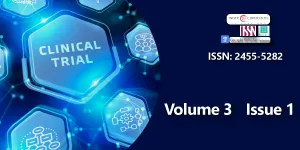Pasteurella Canis as a Cause of Septic Arthritis and Soft Tissue Infection after Sheep Bite: A Case Report
Main Article Content
Abstract
Pasteurella spp is the first organisms to consider in any patient who presents with a soft tissue infection following cat or dog bites. Pasteurella canis is most common isolate of dog bites, but there are no reports of pastereulla canis infection caused by sheep bite. A case of a 66 years old farmer woman with symptoms of infected left hand with wrist septic arthritis, after a lamb bite is described (the sheep was sick after a dog bite). Microbiological examination of the wrist articular liquid was performed. The specimen was both aerobic and anaerobic cultures were performed. After 24 hours, growth of smooth, greyish-white colonies was observed only on Columbia agar. Another Gram stained slide was performed from those colonies and Gram negative cocobacilli to short rod shaped morphology with bipolar staining was observed. They demonstrate positive catalase and oxidase positive reaction. The bacterium was susceptible to all tested antimicrobial agents. Although systemic forms of Pasteurella are possible, cutaneous infections from animal bites are the most common presentation. Most animal-bite injuries can be treated with oral antimicrobials on an outpatient basis, but in this case the patient needed intravenous antimicrobial aggressive therapy.
Downloads
Article Details
Copyright (c) 2016 Ramiro GV, et al.

This work is licensed under a Creative Commons Attribution 4.0 International License.
Oehler RL, Velez AP, Mizrachi M, Lamarche J, Gompf S (2009) Bite-related and septic syndromes caused by cats and dogs. Lancet Infect Dis 9: 439-447.
Aziz H, Rhee P, Pandit V, Tang A, Gries L, et al. (2015) The current concepts in management of animal (dog, cat, snake, scorpion) and human bite wounds. J Trauma Acute Care Surg 78: 641-648.
Abrahamian FM, Goldstein EJ (2011) Microbiology of Animal Bite Wound Infections. Clin Microbiol Rev 24: 231-246 .
Hon KL, Fu CC, Chor CM, Tang PS, Leung TF, et al. (2007) Issues associated with dog bite injuries in children and adolescents assessed at the emergency department. Pediatr Emerg Care 23: 445-449.
Peel MM, Hornidge KA, Luppino M, Stacpoole AM et al. (1991) Actinobacillus spp. and related bacteria in infected wounds of humans bitten by horses and sheep. J Clin Microbiol 29: 2535–2538.
Kannikeswaran N, Kamat D (2009) Mammalian bites. Clin Pediatr (Phila) 48: 145-148.
Harper M, Boyce JD, Adler B (2004) Pasteurella multocida pathogenesis: 125 years after Pasteur. FEMS Microbiol Lett 265: 1-10.
Donnio PY, Lerestif-Gautier AL, Avril JL (2004) Characterization of Pasteurella spp. strains isolated from human infections. J Comp Pathol 130: 137-142.
American Academy of Pediatrics (2015) Pasturella infections. In: Red Book: 2015 Report of the Committee on Infectious Diseases, 30th, Kimberlin DW, Brady MT, Jackson MA, Long SS (Eds), American Academy of Pediatrics, Elk Grove Village IL 596.
Jorgensen JH, Hindler JF (2007) New consensus guidelines from the Clinical and Laboratory Standards Institute for antimicrobial susceptibility testing of infrequently isolated or fastidious bacteria. Clin Infect Dis 44: 280-286.
Stevens DL, Bisno AL, Chambers HF, Dellinger EP, Goldstein EJ, et al. (2014) Practice guidelines for the diagnosis and management of skin and soft tissue infections: 2014 update by the infectious diseases society of America. Clin Infect Dis 59: e10-52.
Chodakewitz J, Bia FJ (1988) Septic arthritis and osteomyelitis from a cat bite. Yale J Biol Med 61: 513-518.
Kawashima S, Matsukawa N, Ueki Y, Hattori M, Ojika K, et al. (2010) Pasteurella multocida meningitis caused by kissing animals: a case report and review of the literature. J Neurol 257: 653-654.
O'Neill E, Moloney A, Hickey M (2005) Pasteurella multocida meningitis: case report and review of the literature. J Infect 50: 344-345.
Chang K, Siu LK, Chen YH, Lu PL, Chen TC, et al. (2007) Fatal Pasteurella multocida septicemia and necrotizing fasciitis related with wound licked by a domestic dog. Scand J Infect Dis 39: 167-170.
Brook I (2009) Management of human and animal bite wound infection: an overview. Curr Infect Dis Rep 11: 389-395.
Baron EJ, Miller JM, Weinstein MP, Richter SS, Gilligan PH, et al. (2013) A guide to utilization of the microbiology laboratory for diagnosis of infectious diseases: 2013 recommendations by the Infectious Diseases Society of America (IDSA) and the American Society for Microbiology (ASM) (a). Clin Infect Dis 57: e122-e121.

